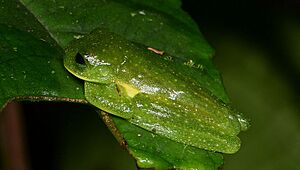Centrolene ballux facts for kids
Quick facts for kids Centrolene ballux |
|
|---|---|
 |
|
| C. ballux in Pichincha, Ecuador | |
| Conservation status | |
| Scientific classification | |
| Synonyms | |
|
Centrolenella ballux Duellman and Burrowes, 1989 |
Centrolene ballux is a special kind of frog known as a glass frog. It belongs to the family Centrolenidae. These frogs are found in a few different places in the mountains of southern Colombia and northern Ecuador. People sometimes call it the golden-flecked glassfrog because of its tiny gold spots, or Burrowes' giant glass frog.
Contents
What's in a Name? The Ballux Frog
The scientific name ballux comes from a Latin word. It means "gold dust." This name was chosen because this frog has tiny gold specks on its back.
What Does the Ballux Frog Look Like?
These frogs are quite small. Adult males are about 19 to 22 millimeters long. That's less than an inch! Females are a little bigger, around 21 to 23 millimeters long.
Their snout, or nose area, is rounded. Both their fingers and toes have webbing, which helps them move around. You can also see their eardrum.
The back of the frog is a dark lime green color. It has very small, pale gold-white flecks, especially on its back legs. The tips of its fingers and toes are yellowish-green. The belly of the frog is clear, or translucent. This is why they are called "glass frogs."
Where Does the Ballux Frog Live?
The Centrolene ballux frog lives in humid mountain forests. These forests are found high up, between 1,700 and 2,340 meters above sea level. You can often find them on plants about 50 to 200 centimeters above the ground. They usually stay near streams or ditches.
These frogs lay their eggs and raise their young in streams.
Why Is the Ballux Frog in Danger?
Sadly, the Centrolene ballux is an endangered species. This means there are not many of them left. Several things threaten their survival:
- Changes in weather patterns: Changes in the climate can affect the humidity they need to survive.
- Loss of habitat: The places where they live are being destroyed.
- New fish: Sometimes, new kinds of fish are introduced to their streams. These fish might eat the frogs or their eggs.
- Pollution: Water pollution can harm the frogs.
- Frog disease: A serious frog disease called chytridiomycosis also puts them at risk.
Luckily, some areas are working to protect these special frogs. They live in the Reserva La Planada, a private reserve in Colombia. They are also found in the Reserva Las Gralarias in Ecuador.


